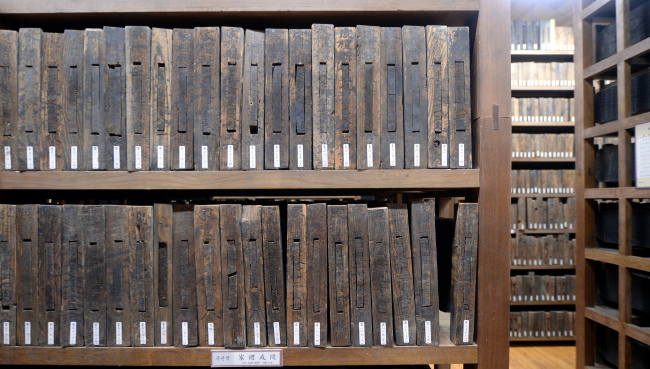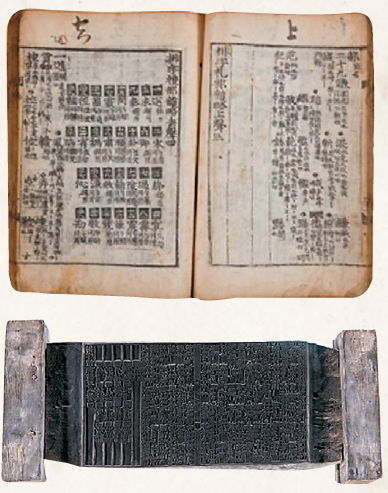ANDONG, North Gyeongsang Province ― They say to see the real Korea, one must visit Andong, the home of Korean Confucianism. But even in this historic city, the real gems are hidden far off the beaten track.
One such treasure waiting to be discovered is the collection of tens of thousands of woodblocks housed at Jangpangak, a storage facility in a peaceful little town called Seobu-ri.
Tucked away at the foot of a hill overlooking the hamlet and a nearby lake, Jangpangak is the depository of the 64,226 Confucian printing woodblocks that researchers say hold a special place in world history.
Collected and preserved by the Advanced Center for Korean Studies, the relics, up to 500 years old, are Korea’s candidate for the UNESCO Memory of the World Register. A decision on the application is due in June 2015.
Inside Jangpangak
The weather on Dec. 8 was cold and frosty, with the previous night’s snow still covering much of the ACKS compound.
Stepping inside Jangpangak was like entering another world, with no hint of the winter chill outside.
The interior looked just like a library, except that what were stored on the wooden shelves were not books, but woodblocks that were carved to print books. The air smelled different, too.
One such treasure waiting to be discovered is the collection of tens of thousands of woodblocks housed at Jangpangak, a storage facility in a peaceful little town called Seobu-ri.
Tucked away at the foot of a hill overlooking the hamlet and a nearby lake, Jangpangak is the depository of the 64,226 Confucian printing woodblocks that researchers say hold a special place in world history.
Collected and preserved by the Advanced Center for Korean Studies, the relics, up to 500 years old, are Korea’s candidate for the UNESCO Memory of the World Register. A decision on the application is due in June 2015.
Inside Jangpangak
The weather on Dec. 8 was cold and frosty, with the previous night’s snow still covering much of the ACKS compound.
Stepping inside Jangpangak was like entering another world, with no hint of the winter chill outside.
The interior looked just like a library, except that what were stored on the wooden shelves were not books, but woodblocks that were carved to print books. The air smelled different, too.

“It’s wood, ink, dust and fumigant all combined,” said Park Soon, a senior researcher at the ACKS.
“Everything here is automatically maintained ― the temperature, humidity, fire prevention and so on,” he said. “Our very presence here now is a potential risk factor.”
The two buildings of Jangpangak are a typical case of “old meets new.”
Centuries-old techniques are used along with state-of-the-art preservation, antifire and antitheft systems.

The temperature and humidity are automatically maintained at ideal levels, but the wooden shelves and floor help absorb excess moisture as needed. In the event of a fire inside, each building is equipped with a fire alarm and a suppression system, using halon gas.
“For ventilation, we took a cue from Janggyeong Panjeon (at Haeinsa Temple, which houses the Tripitaka Koreana woodblocks),” he said.
Just like Janggyeong Panjeon, a 15th-century invention that was registered in 1995 as a UNESCO world heritage for its scientific preservation properties, each wall has an upper and lower window, but the windows have different sizes.
Fresh air flows in naturally through the larger window, and fully circulates within the building before being let out through the windows on the opposite side, he explained.
“When the weather is dry and crisp, we leave all the windows open for ventilation.”
Precious timbers
“Most of the panels here have yet to be studied,” Park said, adding that the academic study of Joseon-era printing woodblocks began only about three to four years ago.
“Some people may say, why study woodblocks if the print book is available? But these woodblocks reveal stories that can’t be learned from the print books,” he said.
According to him, woodblocks have a variety of information engraved in or written in ink on the end pieces or on their surfaces that was not actually part of the content of a collection. They include the names of the engravers, as well as those who led the publishing.
“It is a good resource for microhistory studies of local communities at the time,” the researcher said.
In a book-publishing culture that is unique in world history, Joseon scholars and intellectuals led the woodblock production in a process that researchers now describe as “community publishing.” They decided what to publish, oversaw the entire publishing process and divided up the required costs among themselves.
“Sometimes we find woodblocks with a mark of ‘not usable.’ They look fine, which means that the problem was the content,” Park said.
In such a case of censorship, the printed book of 19th-century Confucian scholar Jang Seok-young leaves out parts mentioning illegitimate children born of a concubine.
“It must have been something that the Jang clan wanted to hide,” Park explained. “If we don’t have the woodblocks now, we would never be able to know the whole story.”
● Researchers and other individuals wishing to view the woodblocks in Jangpangak may do so upon permission from the Advanced Center for Korean Studies.
● For an online catalogue of the collection, visit mokpan.ugyo.net/en/index.html.
By Lee Sun-young (milaya@heraldcorp.com)
-
Articles by Korea Herald








![[KH Explains] Hyundai's full hybrid edge to pay off amid slow transition to pure EVs](http://res.heraldm.com/phpwas/restmb_idxmake.php?idx=644&simg=/content/image/2024/04/18/20240418050645_0.jpg&u=20240419100350)







![[From the Scene] Monks, Buddhists hail return of remains of Buddhas](http://res.heraldm.com/phpwas/restmb_idxmake.php?idx=652&simg=/content/image/2024/04/19/20240419050617_0.jpg&u=20240419175937)

![[KH Explains] Hyundai's full hybrid edge to pay off amid slow transition to pure EVs](http://res.heraldm.com/phpwas/restmb_idxmake.php?idx=652&simg=/content/image/2024/04/18/20240418050645_0.jpg&u=20240419100350)

![[Today’s K-pop] Illit drops debut single remix](http://res.heraldm.com/phpwas/restmb_idxmake.php?idx=642&simg=/content/image/2024/04/19/20240419050612_0.jpg&u=)